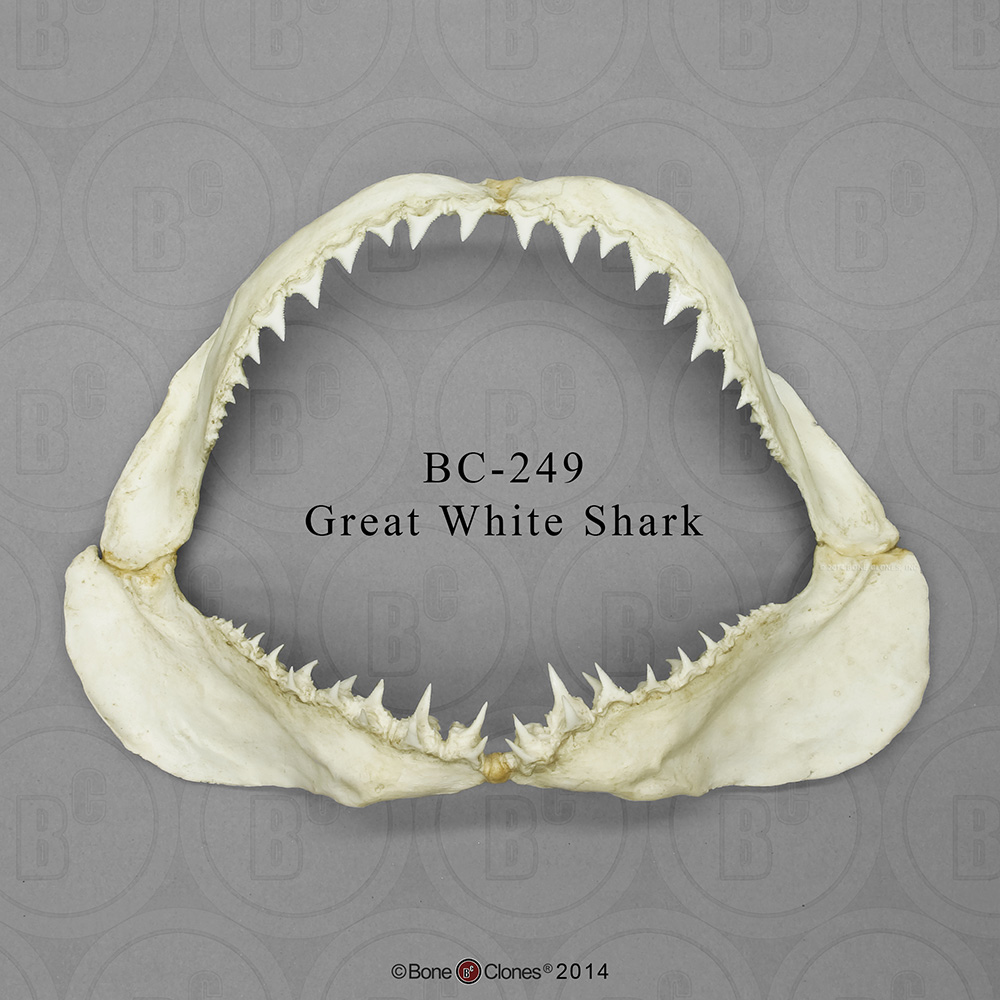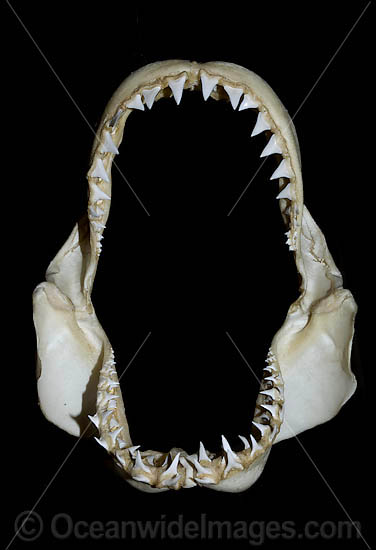That”s exactly what makes it possible for us to know so many teeth! It doesn’t diminish the chance of finding particularly big specimens, on the contrary.
Have you verified what you hypothetise should yield higher estimates?
Kent certainly knows what he is talking about, and he is also aware of that great white specimen. And we can observe it:

here the adjacent roots have very little, if any, space in between. some of them definitely touch.

same here.

and here

This last one has much greater spacing, which is where I took the 15% from. that’s of course a ballpark estimate due to our obvious inability to measure it precisely from an image with perspective, but that’s the best we have for now.
A precise average spacing would be preferable, but it is not available. The figure from Newbrey et al. is within the range of reasonable possibilities. The shark from bone-clones must have been close to the upper end as far as spacing goes, and a bit longer than would be predicted, or, it has abnormally big spacing. Or, less likely, there’s a total sampling bias and Kent is wrong too.
I hope I’don’t have to repeat it again.
If you dismiss this I’m certainly not the one who belittles someone...
All shark jaws I’ve found have spacing of 15% or less. More is not reasonable to assume based on the evidence, if you have got better data, post them. I had already written that some time ago.
Can you post that video?
The problem is that the first you consider is that something with my calculation is wrong, even if since pages you found no evidence or better alternative, but you don’t consider that his upper estimates are probably simply due to the use of different sharks, methods from different sources, simplistic ratios like the one you posted, or whatever.
As you can see there is variation, although much less than with single tooth measurements. But that’s not the point, I’m not merely talking about an outlier in terms of jaw perimeter-body lenght, there are multiple other factors.
As you see there are multiple specimens atound 5.5m long, which show a marked disparity in perimeter. This does not necessarily translate to Lowry et al.’s formula for toothrow lenght, but it is certainly possible that there are outliers.
Well, I guess if I was claiming there were tons of adult
T. rex specimens below 10m, you’d ask for their specimen numbers...
But I guess you have seen
coherentsheaf’s post by now. There are three, and two of them are very large. So the 12-13m size is more likely quite normal for
P. macromerus, and the smaller one is rather an analogue to the Belgiom collumn.
Was he? If he did, you should be the one to verify it.
I don’t think there is any more rigorous data suggesting the Oxford mandible to be particularly old than there is suggesting the smaller specimen to be particularly young.
You see, an interesting insight can be gained from comparing the actual dead specimens that we found! They are similarly likely to die, and all not likely to be fully grown.
So what?
You’ve got me wrong. Such a program does not seem to exist. I didn’t even find one giving satisfactory results with papers I had only downladed in Image formats. With an old, scanned, japanese one, it won’t get better. Not to mention the result has to be good enough for an automatic translator software to work on it (which it won’t if there are errors due to the character recognition).
That is by no means a contradiction. Overall, the biggest members of the biggest populations remain exceptional, albeit less so for their respective geographical or geological range or sex. that different populations show marked size differences is, again, nothing unusual.
That a species can possibly be further subdivided depending on the region is nothing unusual, and it certainly doesn’t change that there are sizes typical for it, and sizes that aren’t. So as long as we are not discussing speculative subspecies, but keeping this at species level (this is a thread about
C. megalodon, not about "the largest
C. megalodon subsp."), it doesn’t change a thing. C. megalodon’s range of intraspecific variation is nothing unheard of.
I don’t think jaw reconstruction commonly acknowledged to be inaccurate and nitpicking the largest available teeth is not the best proof...
"More compact dentition"
Grey, could you please, when reporting my arguments, try to be accurate? If you do not remember them, don’t talk about them, or look them up.
That was not the point.
C. megalodon’s front teeth are lower, and its rear teeth are taller, relative to the size of the mouth. Overall, the disparity between anterior and posterior is much greater in great whites. That is, unless both the picture
Grey posted above, the boneclones dentition, and more or less every great white jaw I’ve ever seen are massively abnormal in this regard.
So, unless for example a single tooth is a better predictor of total lenght than the overall tooth width in the mouth (bobody here would presume that I think), using a tooth that is proportionally smaller in the estimated taxon will produce underestimates, and using one that’s proportionally taller will produce overestimates.
I’ve quantified the difference with the boneclones sets:
slant length at same summed tooth width CB-11 CH-31 KO-009 (C. carcharias)
A1 142 138.3529411765 171.7670682731
A2 138 134.0294117647 170.4457831325
A3 118.5 129.7058823529 114.9518072289
L1 129 132.1764705882 147.983935743
L2 137 130.9411764706 150.6265060241
L3 124.5 124.7647058824 144.0200803213
L4 108 113.0294117647 117.59437751
L5 105 96.9705882353 71.3493975904
L6 93.5 72.8823529412 47.5662650602
L7 84 64.2352941176 33.0321285141
L8 57.5 42.6176470588 22.4618473896
L9 45.5 30.2647058824 17.1767068273Teeth of the two
C. megalodon (yorktown=CB-11, Hubbells set= CH-31) and the
C. carcharias tooth sets all scaled to the total upper width of the yorktown dentition. I’m aware the figures are in slant lenght, but this reflects the overall size variation well enough to be valuable. Comparing widths, the difference is much much smaller, so it mainly breaks down to height, and you can see that elsewhere.
You see a cery clear trend, anteriors of
C. megalodon are proportionally shorter (excluding the third anterior), posteriors proportionally longer. Also (unsurprisingly), one can observe that the younger
C. megalodon is more similar to the great white shark, i.e.
C. megalodon displays hypermorphosis in its jaw apparatus, and this trend gets more marked with increasing age.
A linear equation cannot counteract such a difference sufficiently. Especially, this is what makes me disagree with the claims that Shimada’s method was generally "conservative", and I think you see this reflected in that you rarely see particularly large estimates made with it for anterior and anterior lateral teeth, but often for posterior and posterior laterals.
And just out of curiosity, have you ever tried making estimates with Shimada’s methods for one of the two sets, and comparing the estimates you get from different teeth in the same specimen? I got some very strange results, But I’d be interested to first see whether they match what others get, or whether that was just a calculation error.
@life: What’s wrong with quantitative data (anatomy and palaeontology are, above all, a quantitative science. All the more considering it often requires restoration and size estimates!), and why should this give us minimum estimates? Every lifeform has constraints, and there is no reason to presume the constraints on
C. megalodon would allow it to be bigger than would be indicated by the quantitative data of extant sharks.
It’s equally possible it would be smaller. you’re assuming it to have been less restricted, but you have to keep in mind a great white shark scaled up to 15m would simply not be viable at all. We are already assuming it was adapted to cope with larger sizes than any great white (merely not larger sizes than would be indicated by it’s proportions). At the very least, our estimates are average figures, certainly not lower bounds.